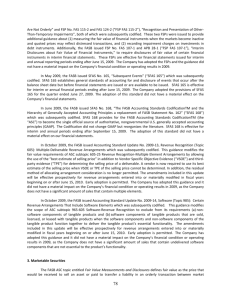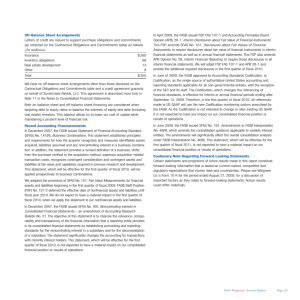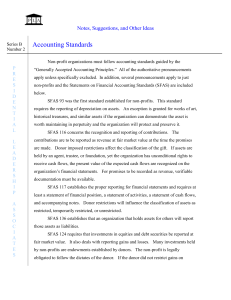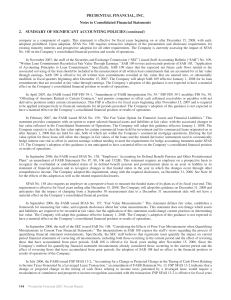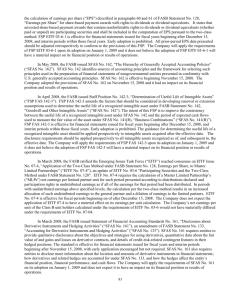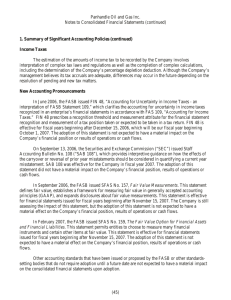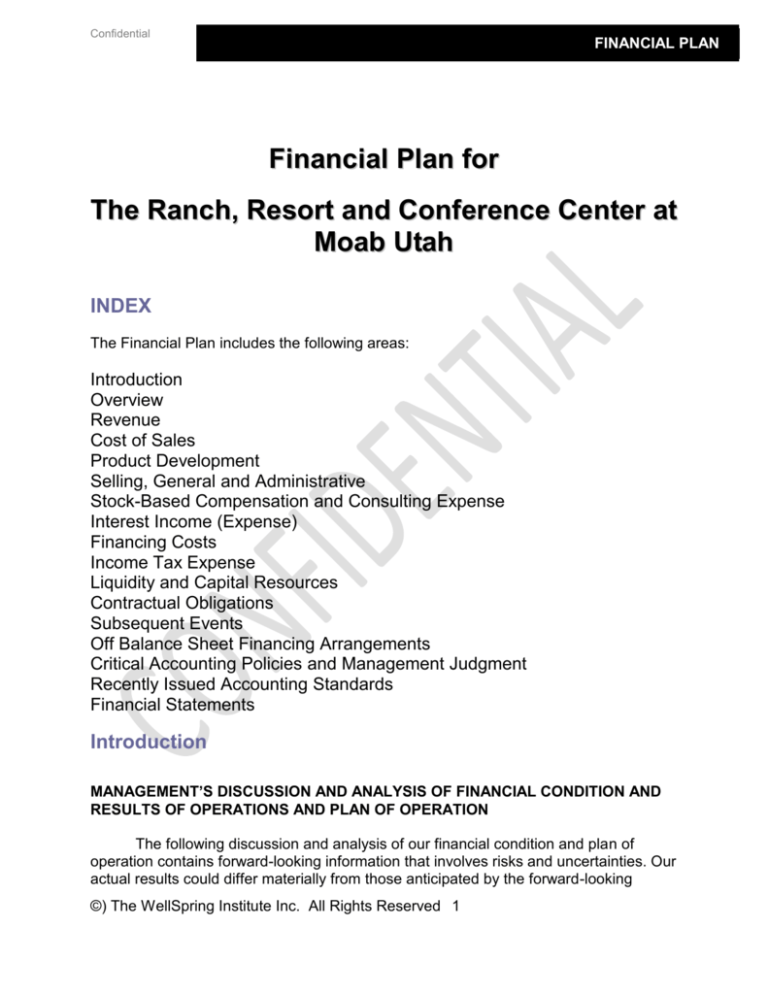
Confidential
FINANCIAL PLAN
F i n a n c i a l P l a n fo r
The Ranch, Resort and Conference Center at
Moab Utah
INDEX
The Financial Plan includes the following areas:
Introduction
Overview
Revenue
Cost of Sales
Product Development
Selling, General and Administrative
Stock-Based Compensation and Consulting Expense
Interest Income (Expense)
Financing Costs
Income Tax Expense
Liquidity and Capital Resources
Contractual Obligations
Subsequent Events
Off Balance Sheet Financing Arrangements
Critical Accounting Policies and Management Judgment
Recently Issued Accounting Standards
Financial Statements
Introduction
MANAGEMENT’S DISCUSSION AND ANALYSIS OF FINANCIAL CONDITION AND
RESULTS OF OPERATIONS AND PLAN OF OPERATION
The following discussion and analysis of our financial condition and plan of
operation contains forward-looking information that involves risks and uncertainties. Our
actual results could differ materially from those anticipated by the forward-looking
©) The WellSpring Institute Inc. All Rights Reserved 1
Confidential
FINANCIAL PLAN
information. Factors that may cause such differences include, but are not limited to,
availability and cost of financial resources, product demand, market acceptance and
other factors discussed in this Memorandum under the heading “Risk Factors”. This
discussion and analysis of our financial condition and plan of operation should be read
in conjunction with our financial statements and the related notes included elsewhere in
this Memorandum.
The accompanying management’s discussion and analysis of financial condition
and results of operations and plan of operation gives effect to the restatement of our
consolidated financial statements for the year ended 2009.
OVERVIEW
The Formation of The Ranch
From inception to date, we have been primarily involved in organizational activity
and the creation of a business plan to demonstrate the value added position of a
destination resort called The Ranch Resort and Conference Center (The Ranch).
We expect to negotiate agreements with VARs, distributors, integrators and OEMs that
are currently supplying retail goods and services, real estate sales, training and
development programs, high adventure activities, elder care, youth development and
live stock operation to the world. Initially, we will acquire the land for our operations
from land owners in the Moab area. Then, our VARs, distributors, integrators and OEMs
will sell THE RANCH™ activates to interested parties.
The standard VAR and OEM agreements provide that (i) the related licenses are
non-exclusive; (ii) we are free to accept or reject orders placed by the VAR or OEM,
and acceptances must be in writing; (iii) the pricing and payment terms will be as set
forth in our price list, which we may change unilaterally with 30 days’ notice; (iv) the
initial term is for one year, and the agreement will not continue unless the parties
affirmatively agree to renew the agreement; and (v) we may terminate the agreement
immediately in several situations, including an uncured material breach by the VAR or
OEM. To date, we have not concluded any initial VAR or OEM agreements.
Our costs associated with production of THE RANCH™ services and products will be
based on the services that we decide to offer.
We expect our operating expenses will increase as we increase our transaction
volumes, product development activities, and sales and marketing activities. We
anticipate developing new products and services which will require retesting and
recertification. We anticipate that over the next 12 months that our operating expenses
will increase at a faster rate relative to the rate of increase in our revenues during this
same period.
©) The WellSpring Institute Inc. All Rights Reserved 2
Confidential
FINANCIAL PLAN
We expect our principal activities over the next 12 months to include due
diligence, construction, infrastructure development, product development, sales and
marketing, and general and administration costs. We anticipate that our most significant
costs related to the activities described above will include the following items:
Land development expenses, including consulting fees, permits and associated
travel, engineering and design services.
Construction costs
Sales and marketing expenses, which consist primarily of consulting fees,
associated travel expenses, promotional expenses and the costs of programs
aimed at increasing revenue such as advertising, trade shows, public relations
and other market development programs; and
General and administrative expenses, which consist of information systems
costs; legal, accounting and other professional fees; and other corporate costs.
We anticipate funding for the activities described above will come principally
from some or all of the following sources: working capital generated from the sale of
current WellSpring product’s and services, sales of additional securities and debt
financing. Currently we are working on other financial arrangements or lines of credit
with lenders.
Our initial product, of training and development courses and workshops, is ready
for sale. Pursuant to the funding to be acquired from this offering, the Company will
launch its Entrepreneurial Fast track program and other executive development training
programs.
Effective internal controls are necessary for us to provide reliable financial
reports. If we cannot provide reliable financial reports, our operating results could be
misstated, our reputation may be harmed and the future price of our stock could be
negatively affected. We are a development stage company with limited personnel and
other resources. As a result, we have in the past discovered, and may in the future
discover, areas in our internal controls that need improvement. For this reason, we are
contracting with an outside company (The WellSpring Institute) that will provide their
experienced financial and accounting systems during our start-up phase of operations.
There can be no assurance that our controls over financial processes and reporting will
be effective in the future.
(2009) (un-audited)
Revenue
We began development of our training and development programs in 1990, and
expect to aggressively market these programs in the fourth quarter of 2009. We have
received interest for many of these programs and have had them evaluated as some of
the best in the world by not only participants but formal universities studies as well. We
©) The WellSpring Institute Inc. All Rights Reserved 3
Confidential
FINANCIAL PLAN
expect to recognize revenue when the sales and marketing efforts are unleashed and
the Fast Track program is distributed. We believe the units will have a suggested base
retail unit list price of between $350 for 4 hour workshops to over $150K for our week
long boot camps. The VARs and OEMs will sell at prices that will depend on volume
commitments. At volume, the gross margin for the VARs and OEMs are expected to be
approximately 80%. Revenue to the Company will be based on enrollment fees.
Additionally, the Company will seek initial enrollment in our Youth Development
program called Entrada. This program can begin operations with very little capital
commitment. We also expect to begin shipping units and recognize revenue from these
sales during the first quarter of 2010.
Cost of Sales
Cost of sales will consist primarily of direct costs of the training programs, wages
of operational employees, outsourcing costs for infrastructure development and cost of
sales and marketing. Many factors are anticipated to affect our gross margin including,
but not limited to, market conditions, competition, infrastructure development costs,
testing and supplier pricing. Our management currently does not anticipate that we will
operate our own support staff, but instead will outsource these services to a third party
provider, The WellSpring Institute. We are currently incurring cost of sales as we move
forward with the development of our organization and our training and development
sales.
Product Development
Product development expenses incurred in the design, development and testing
of our product include compensation and benefits for management and staff,
engineering and consulting services, and other miscellaneous expenses.
Product development expense represented 20% of total operating expenses
during the first-12 months. In the future, the rate of product development spending
related to the training and development products and services is likely to decrease as
we launch our products world wide.
Selling, General and Administrative
Selling, general and administrative expenses include all corporate and
administrative functions that serve to support our current and future operations and
provide an infrastructure to support future growth. Major items in this category,
beginning in 2010, will include outsourced infrastructure development, compensation
and benefits for management and staff, travel related expenses and professional
services. In the future, the rate of spending on selling and marketing is expected to
©) The WellSpring Institute Inc. All Rights Reserved 4
Confidential
FINANCIAL PLAN
increase significantly as we add headcount for our SBU heads, expand our marketing
campaign for The Ranch and participate in industry and trade shows.
General and administrative expenses have not been assessed to date because
of lack of funds. We anticipate back paying for some of these services when funding is
obtained. We expect that total spending on general and administrative expenses will
increase in the future due to increased headcount, expansion of corporate facilities and
related equipment offset by reduced spending on professional services. However, we
expect that spending on general and administrative items as a percentage of total
operating expenditures will decrease relative to other operating activities including sales
and marketing and product development.
Stock-based Compensation and Consulting Expense
We have not recorded any stock-based compensation to date. Consulting
expenses are low for the services currently being rendered. This will change as the
Company makes the transition to normal operations.
Interest Income (Expense)
The Company has no Interest income or expense to date. Interest expense on
the loans offered in this memorandum may be compensated by the revenues generated
by all of Scott Bairds' Organizations including: The WellSpring Institute, Strategic
Human Resources Solutions, Extreme Party Toys of Utah and Interest on preliminary
20 million dollar investment.
Financing Costs
It is estimated that over 1 million dollars has been invested by the company
founder in the development of the training, human resources and organizational
behavior products and service. An additional investment of $20,000,000 has been
promised by an outside investor for exchange of 10% ownership in the organization.
Income Tax Expense
Since inception, we have not recorded any revenue or expenses and therefore
are not subject to federal and state income tax.
LIQUIDITY AND CAPITAL RESOURCES
Since inception, cash used in operations has been absorbed by The WellSpring
Institute and Scott Baird.
©) The WellSpring Institute Inc. All Rights Reserved 5
Confidential
FINANCIAL PLAN
Since inception, we have incurred approximately $45,000 in business
development expenditures. Future requirements will include computers, office
equipment, software and similar equipment. We anticipate significant capital
expenditure spending in the future for land, construction of buildings and landscapes,
livestock, capital equipment and machinery. Our primary source of liquidity has been
proceeds generated from founder’s contributions. The principal uses of cash have been
for product development and general and administrative expenses.
In light of the limited stockholders’ equity as well as our lack of operating history,
there can be no assurance that we will be able to obtain the necessary additional
capital on a timely basis or on acceptable terms, if at all, to fund the capital that may be
required for the development of our business. In any of such events, the growth of our
business and prospects would be materially and adversely affected. As a result of any
such capital financing, if available, the holders of the common stock may experience
substantial dilution.
Since inception, we have generated a limited amount of revenue and there can
be no assurance that we will generate revenue in the future.
CONTRACTUAL OBLIGATIONS
At this time we have no contractual obligation tied to this organization
OFF BALANCE SHEET FINANCING ARRANGEMENTS
The Company does not have any off balance sheet financing arrangements.
CRITICAL ACCOUNTING POLICIES AND MANAGEMENT
JUDGMENT
Below is a brief description of key accounting principles which we have adopted
in determining our recognition of revenues and expenses.
Revenue Recognition
We intend to recognize revenue in accordance with the SEC Staff Accounting
Bulletin (SAB) No. 101, Revenue Recognition in Financial Statements as updated by
SEC Staff Accounting Bulletin No. 104, Revenue Recognition. Under these guidelines,
revenue is recognized when persuasive evidence of an arrangement exists, shipment
has occurred or services rendered, the price is fixed or determinable and payment is
reasonably assured. Under these requirements, when the terms of sale include
customer acceptance provisions, and compliance with those provisions has not been
previously demonstrated, revenues are recognized upon acceptance. We are in our
©) The WellSpring Institute Inc. All Rights Reserved 6
Confidential
FINANCIAL PLAN
development phase and have limited customers and revenue. To date, we have
delivered no products to customers. We continue to operate in the development stage
and have not recognized substantial revenue to date.
Stock Based Compensation
Awards under our future stock option plans will be accounted for in accordance
with Statement of Financial Accounting Standards (SFAS) No. 123R (SFAS 123R)
Share Based Payment, and SAB No. 107. We adopted SFAS 123R under the modified
prospective method. In accordance with the modified prospective transition method, our
Consolidated Financial Statements for prior periods have not been restated to reflect,
and do not include, the impact of SFAS 123(R). Prior to the adoption of SFAS 123(R),
there were no awards outstanding being accounted for under APB No. 25, therefore,
the future impact of adopting 123(R) is limited to the fair value of future grants.
Compensation is measured on the grant date of an award and recognized over the
service period for which the award was granted, generally the vesting period. For
awards with graded vesting, compensation is recorded using the straight line method
over the vesting period, but in no event shall total compensation recognized under the
awards be less than the aggregate fair value of shares vested under such awards.
Compensation is equal to the fair value of the award which we determine using a
binomial option-pricing model.
Income Taxes
We account for income taxes using the asset and liability method, as provided by
SFAS 109, Accounting for Income Taxes (SFAS 109) which requires the recognition of
different tax assets and liabilities for the future tax consequences of temporary
differences between the financial statement and tax basis carrying amounts of assets
and liabilities. No income taxes were provided since we have incurred losses from our
inception. Due to the uncertainty of future taxable income, no future tax benefits have
been recognized.
RECENTLY ISSUED ACCOUNTING STANDARDS
Effective February 3, 2006, the FASB decided to move forward with the issuance
of a final FSP FAS 123R-4, Classification of Options and Similar Instruments Issued as
Employee Compensation That Allow for Cash Settlement upon the Occurrence of a
Contingent Event. The guidance in this FSP FAS 123R-4 amends paragraphs 32 and
A229 of FASB Statement No. 123R to incorporate the concept articulated in footnote 16
of FAS 123R. That is, a cash settlement feature that can be exercised only upon the
occurrence of a contingent event that is outside the employee’s control does not meet
the condition in paragraphs 32 and A229 until it becomes probable that the event will
occur. Originally under FAS 123R, a provision in a share-based payment plan that
required an entity to settle outstanding options in cash upon the occurrence of any
contingent event required classification and accounting for the share based payment as
©) The WellSpring Institute Inc. All Rights Reserved 7
Confidential
FINANCIAL PLAN
a liability. This caused an issue under certain awards that require or permit, at the
holder’s election, cash settlement of the option or similar instrument upon (a) a change
in control or other liquidity event of the entity or (b) death or disability of the holder. With
this new FSP, these types of cash settlement features will not require liability
accounting so long as the feature can be exercised only upon the occurrence of a
contingent event that is outside the employee’s control (such as an initial public
offering) until it becomes probable that event will occur. The guidance in this FSP shall
be applied upon initial adoption of Statement 123(R). An entity that adopted Statement
123(R) prior to the issuance of the FSP shall apply the guidance in the FSP in the first
reporting period beginning after February 2006. Early application of FSP FAS 123R-4 is
permitted in periods for which financial statements have not yet been issued. We do not
anticipate that this new FSP will have any material impact upon our financial condition
or results of operations.
The adoption of the following recent accounting pronouncements did not have a
material impact on our results of operations and financial condition:
Emerging Issues Task Force (EITF) Issue No. 03-1, The Meaning of Other-ThanTemporary Impairment and Its Application to Certain Investments.
In December 2004, the FASB issued SFAS No. 153, Exchanges of Nonmonetary Assets—an amendment of APB opinion No. 29 (SFAS 153). SFAS 153
clarifies that exchanges of non-monetary assets should be measured based on the fair
value of the assets exchanged, with a general exception for exchanges that have no
commercial substance. SFAS 153 is effective for non-monetary asset exchanges
occurring in fiscal periods beginning after June 15, 2005.
In May 2005, the FASB issued SFAS No. 154 “Accounting Changes and Error
Corrections—a replacement of APB Opinion No. 20, and FASB Statement No. 3.”
(SFAS 154) SFAS 154 replaces APB Opinion No. 20, Accounting Changes, and FASB
Statement No. 3, Reporting Accounting Changes in Interim Financial Statements, and
changes the requirements for the accounting for and reporting of a change in
accounting principle. This statement applies to all voluntary changes in accounting
principle. It also applies to changes required by an accounting pronouncement in the
unusual instance that the pronouncement does not include specific transition
provisions. When a pronouncement includes specific transition provisions, those
provisions should be followed. SFAS 154 is effective for accounting changes and
corrections of errors made in fiscal years beginning after December 31, 2005.
In February 2006, the Financial Accounting Standards Board issued SFAS
No. 155, “Accounting for Certain Hybrid Financial Instruments—an amendment of
FASB Statements No. 133 and 140.” SFAS No. 155 simplifies the accounting for certain
hybrid financial instruments, eliminates the FASB’s interim guidance which provides
that beneficial interests in securitized financial assets are not subject to the provisions
©) The WellSpring Institute Inc. All Rights Reserved 8
Confidential
FINANCIAL PLAN
of SFAS No. 133, “Accounting for Derivative Instruments and Hedging Activities,” and
eliminates the restriction on the passive derivative instruments that a qualifying specialpurpose entity may hold. SFAS No. 155 is effective for all financial instruments acquired
or issued after the beginning of an entity’s first fiscal year that begins after
September 15, 2006.
In July 2006, the FASB issued FASB Interpretation No. 48, Accounting for
Uncertainty in Income Taxes—an interpretation of FASB Statement No. 109 (“FIN 48”),
which clarifies the accounting for uncertainty in tax positions. This Interpretation
requires that we recognize the impact of a tax position in our financial statements if that
position is more likely than not of being sustained on audit, based on the technical
merits of the position. The provisions of FIN 48 will be effective as of the beginning of
our 2007 fiscal year. We are currently evaluating the impact of FIN 48.
In July 2006, the FASB issued FASB Staff Position (FSP) No. FAS 13-2,
“Accounting for a Change or Projected Change in the Timing of Cash Flows Relating to
Income Taxes Generated by a Leveraged Lease Transaction,” that provides guidance
on how a change or a potential change in the timing of cash flows relating to income
taxes generated by a leveraged lease transaction affects the accounting by a lesser for
the lease. We will adopt this staff position on January 1, 2007.
In July 2006, the Emerging Issues Task Force Reached Consensus on Issue No.
06-03 “How Taxes Collected from Customers and Remitted to Governmental
Authorities Should Be Presented in the Income Statement (That Is, Gross Versus Net
Presentation),” that provides guidance on how sales tax collected from customers
should be presented in the income statement. We will adopt this statement
immediately, and will disclose the caption in which sales tax is recorded in accordance
with the consensus reached in this issue when sales tax has been collected.
1) Together these form a reasonable estimate of your company's financial future.
More importantly, however, the process of thinking through the financial plan will
improve your insight into the inner financial workings of your company.
2) Describe the assumptions you made to develop your financial statements (your
business assumptions, not the numbers you entered into the financial
spreadsheets).
3) Everything you have included so far in you business plan, builds your case for
your assumptions. This is where you will face the most challenges from investors
and others—what numbers go in at the beginning… How did you arrive at them?
Can you back them up? How they will change over time due to circumstances
you presume, forecast, create, etc. The rest is arithmetic (we’ve done it all for
you!)
Financial Statements
Detailed financial statements are found in the financials Analysis section to follow
©) The WellSpring Institute Inc. All Rights Reserved 9
Confidential
FINANCIAL PLAN
Gross Profit Analysis
The Gross Profit Analysis in the financial analysis section shows pro-forma
monthly sales revenues, cost of goods sold and gross profit values for each of our
product lines for our first year.
Budget
The Budget section identifies the spending and revenue based on goals, and
time lines and milestones for the companies growth and development
Income Statements
The Income Statement in the Financials section of this business plan reflects
year one by month, years two and three by quarter, and years four and five as annual
figures.
Balance Sheet
The Balance Sheet in the Financials section of this business plan reflects year
one by month.
Break-Even Analysis
The Break-Even Analysis in the Financials section indicates that the break-even
point will be reached in 2010.
Cash Flow Statements
The Cash Flow Statement in the Financials section of this business plan reflects
year one by month, years two and three by quarter, and years four and five as annual
figures.
©) The WellSpring Institute Inc. All Rights Reserved 10

